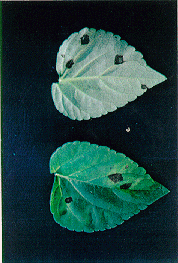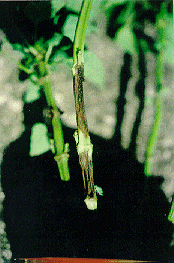
Return to: CFREC Home Page
Return to: CFREC Research Index
University of Florida, IFAS
Central Florida Research and Education Center - Apopka
CFREC-Apopka Research Report, RH-93-12
A. R. Chase*
The first report of a Corynespora leaf spot of a foliage plant was made in 1973 on zebra plant (Aphelandra squarrosa) (4). Since that time, Corynespora cassiicola has been identified as the cause of leaf spots on weeping fig (Ficus benjamina) (3), lipstick vine (Aeschynanthus pulcher) ( 1), china doll (Radermachera sinica), and African violet (Saintpaulia ionantha). Woody ornamentals including azalea (Rhododendron obtusum) (6), hydrangea (Hydrangea macrophylla) (6), and ligustrum (Ligustrum sinense) (5) have also been found infected by this pathogen over the past 20 years. Most recently we have found that the same pathogen can cause a leaf spot and stem rot of the bedding plant Salvia splendens.

Figure 1. Leaf spot of Salvia splendens caused by Corynespora cassiicola.
Symptoms of Corynespora infection on salvias start as small black spots on leaves when plants are no more than an inch tall. At this stage the disease can also cause damping-off due to stem rot at the potting medium surface. Stem rot can occur on plants up to 12 inches tall in 6 inch pots. The rotted areas are usually within 3 inches of the potting medium and can be covered with the black spores of the fungus. Overhead irrigation and rainfall splash these spores all over the lower leaves and cause new leaf infections.

Figure 2. Stem rot of Salvia splendens caused by Corynespora cassiicola.
This disease is very common in both production and the landscape. Plants with an active Corynespora infection will never fill in adequately making a poor showing in the landscape. Some cultivars are very susceptible to stem rot and damping-off such as 'Empire Lilac' and 'Empire Light Salmon'. Other cultivars are more susceptible to the leaf spot phase of the disease ('Red Hot Sally'). Leaf spots can enlarge to 1/4 inch wide and sometimes have a bright yellow halo surrounding the black center. When infections are severe, leaf loss is very common and plant quality is drastically reduced. When Corynespora has been a problem in the landscape, use resistant cultivars such as 'Fuego' to minimize losses in stand quality.
Only two reports of fungicide control have been made on ornamentals infected with C. cassiicola. The first, on Ligustrum sinense, reported good control with benomyl, mancozeb, chlorothalonil or thiophanate methyl (5). However, use of benomyl or thiophanate methyl for a disease caused by C. cassiicola (or the related fungi Alternaria and Helminthosporium) is questionable since these compounds have been shown to increase similar diseases on some ornamentals. A test performed on weeping fig showed both mancozeb and chlorothalonil to provide excellent disease control while benomyl failed to give control (2). At this time, iprodione (Chipco 26019) is the only fungicide registered for use on salvias in Florida which could give good control of this disease. Be sure to test all fungicides for safety before broad scale use on your crops and follow labels for rates and intervals.
*Professor of Plant Pathology, University of Florida, IFAS, Central Florida Research and Education Center - Apopka, 2807 Binion Rd., Apopka, FL 32703-8504.
Pesticides should be applied according to label
directions.
Regardless of the pesticide or mixture of
pesticides used, it is
strongly recommended that the effects be evaluated on a few
plants, under your particular conditions before treating all
plants.
Mention of a commercial or proprietary product
in this paper
does not constitute a recommendation by the authors,
nor does it imply registration under FIFRA as amended.
Reference to University of Florida/IFAS Pest Control Guides
Literature Cited